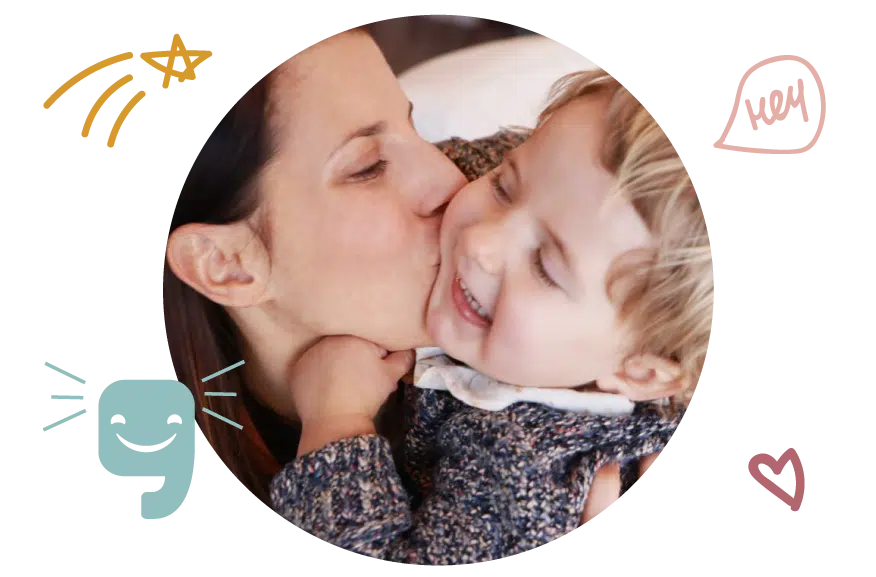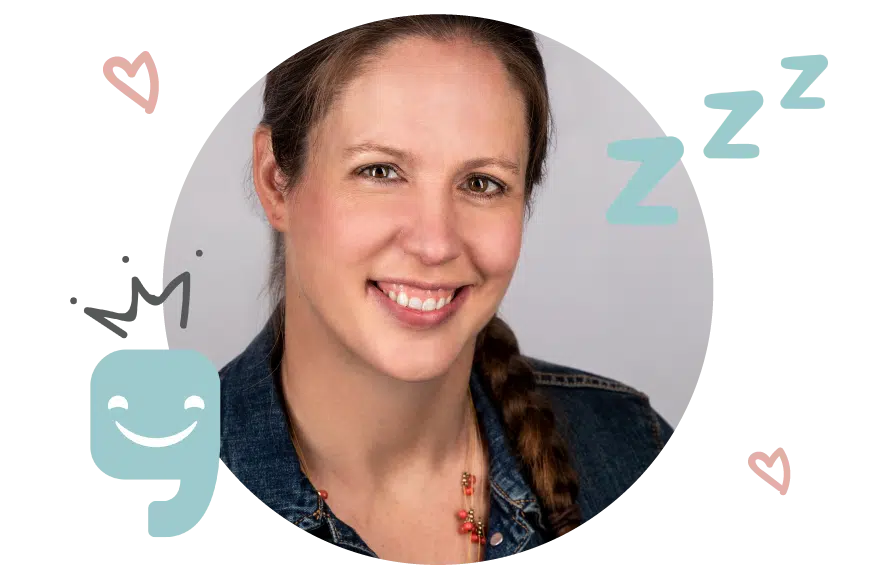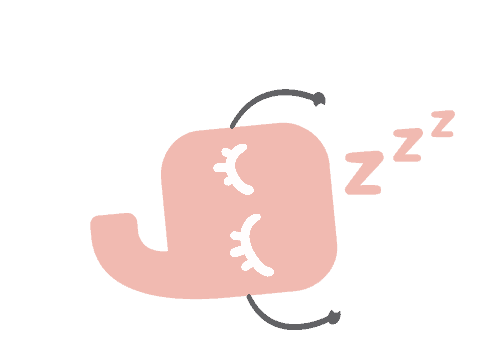Babies Sleep Guide
4 to 6 months
BABY SLEEP STAGE:
4 – 6 months
SLEEP GOALS:
12-16 hours total per day,
including 3-4 naps.
3-5 hours of daytime sleep and 9-12 hours at night.
At 4 months old, your baby’s circadian rhythm is still developing, which helps them organize day time and night time sleep. While your baby is capable of sleeping longer stretches, it’s also very likely that they will go through the famous 4-month sleep regression. This is only temporary. Building healthy sleep habits, like establishing an early bedtime, will get you back on the right track.

4 Month Baby Sleep Guide
Select a topic.
02 - The Biology of Baby Sleep
- Your baby is developing their circadian rhythm, to match the physical, mental, and social activity with the time of day. Initially, babies have a weak circadian rhythm, given to them by their mother’s hormones that crossed through the placenta or through breastmilk. As their own circadian rhythms mature, babies develop longer stretches of consolidated sleep at night and more stable periods of wakefulness during the day.
- Somewhere around 4 months, daytime sleep will also start getting organized.
Your baby’s naps will become more and more regular as weeks pass by. By the time your baby reaches 6 months you can expect naps to happen at the same time every day.
- Your baby’s sleep cycles will also experience a natural development as the brain matures. In fact, these sleep cycles will look more like an adult’s sleep cycles. The duration of each cycle will lengthen to around 50-60 minutes and they will experience different stages of deep sleep.
03 - The Famous 4 Month Sleep Regression
- It’s common to experience sleep regression around Month 4, when babies’ sleep patterns mature, and they become more aware and connected to the world. At this stage, they’ll begin waking up around 4-6 times a night, at the end of each sleep cycle, a pattern that will last their entire life. If your baby is unable to fall back asleep on their own, they might cry and fuss until a grown-up helps him fall back asleep. This is considered sleep regression but it's actually a maturation of your baby's sleep patterns.
- Babies who have been practicing going to sleep independently at the beginning of the night are often able to connect their sleep cycles with no problem. Placing your baby in the crib awake is a good technique for helping them go to sleep independently.
- However babies who are placed into the crib already asleep at bedtime are much more likely to signal or cry when they naturally wake during the night. This is because as humans, we all depend on certain conditions to fall asleep and stay asleep. If you go to sleep with a pillow and you wake up during the night to find that your pillow has fallen, you will pick it up from the floor to go back to sleep. Similarly, if your baby falls asleep in your arms, and they wake up in the middle of the night, they will look for your arms to fall back asleep.
- When your baby reaches this age, most parents believe their baby is waking multiple times a night because they are in pain, hungry or scared. But their waking patterns are actually a consequence of a natural sleep development.
- Parents often try to solve this sleep regression by addressing what they perceive may be the problem. They’ll offer a “hungry” baby multiple feedings a night, or bring a “lonely” baby into their bed. But these solutions may actually compound sleep problems, preventing the baby from practicing falling asleep on their own.
- While every baby wakes several times during the night, not every baby experiences sleep regression. Babies who seem to “sleep through the night” actually wake multiple times. These babies are called “non-signallers.” They do not cry when they wake, and return to sleep quietly.
04 - Sleep Associations
- Sleep associations are the things your baby associates with falling asleep. If these sleep associations are not constantly present, then your baby will likely cry during a natural night waking, needing you to replace the sleep association.
- Choose positive sleep associations that can remain constant throughout the night, such as white noise, the coziness of the crib or bassinet, and even thumb-sucking. These will help baby get back to sleep easily.
- Reduce sleep associations that require your assistance. Feeding to sleep, rocking, walking with baby and even pacifiers that need to be replaced during the night will frustrate your baby (and you!).
- Pacifiers can be a negative sleep association if your baby needs it to be replaced during the night and cannot do so independently. By 6-8 months babies can replace their own pacifiers.
05 - Sleeping and Feeding
- Some babies drop their night feeds at this age, but others need to be fed during the night until they are around 7-9 months old. Always check with your pediatrician your baby's nutritional needs to support a healthy growth.
- If your baby has been feeding to fall asleep, it’s time to switch things up. Try putting feeding at the start rather than the end of your bedtime routine, so baby does not depend on this sleep association to sleep. If your baby associates feeding with sleeping, it will make it harder for them to return to sleep during nighttime wakings.
- For those babies that still need to feed at night, know that they do not necessarily need to feed every time they wake up. If you hear them crying during the night, they may not actually be looking for food, but rather trying to connect sleep cycles and will often fall back asleep within a few moments.
- By 4 months of age, babies usually need 0 to 2 feedings during the night. The first one may be around midnight, after a first long stretch of hours where your baby will mostly be in deep sleep. And a second feeding usually happens 3-4 hours after the first one, around 4-5am.
- Consolidated good quality night sleep is not contingent on removing your overnight feeds. Some babies still do need these night time sessions. Your baby can still achieve good quality sleep simply by meeting his sleep needs, and connecting sleep cycles during the night.
06 - Healthy Sleep Habits
- Consistent (and early) bedtimes will help your baby sleep better. Aim to have your baby down for the night between 6 and 8pm.
- Get into a bedtime routine. A simple ritual that includes feeding, bath, gentle massage and pajamas can help signal to your baby that sleep is pleasant...and predictable.
- During the day, you may want to try a routine that offers your baby to feed, play, sleep. This routine should include acknowledging baby’s sleep signs and putting them down for a nap to prevent overtiredness.
07 - Naps
- Even though naps are still not regular, babies need to sleep during the day. Keep the wake periods around 2 hours long to prevent your baby becoming overtired.
- Watch for sleep signals after about 2 hours of activity and put baby down to sleep to prevent them from becoming overtired.
- Your baby probably needs 3 to 4 naps a day by this stage.
08 - Movement and Sleep
- Your baby is likely experimenting with new movement abilities and starting to roll might be one of them.
- This new skill can affect the quality of their sleep, at least for a few nights. Don’t worry, it’s just a phase!
- While baby is still mastering this skill, they might get stuck on their tummy at some point during the night and not know how to roll back. If you’re not sure if your baby can roll back on his own, the American Academy of Pediatrics recommends you flip them back to keep them to a safe position.
- Let your baby practice during the day. Trust they will soon discover how to roll to their back. Babies start rolling at different times.
- Once your baby can roll both ways, parents can relax and let your baby choose what position is more comfortable during sleep.
09 - Creating a Healthy Sleep Space
- Keep the bedroom pitch black if possible. If a nightlight is needed to help you during night wakings, keep it dim. Red or orange-hued light is less sleep-disruptive than blue or white light.
- Utilize white noise. It’s soothing, and can also help block disruptive noises. (PS: Volume shouldn’t be louder than a bathroom shower!)
- Temperature matters. We sleep best in a cool room. 68-72 degrees is the recommended temperature for infants.
References
- Grigg-Damberger, M., Gozal, D., Marcus, C. L., Quan, S. F., Rosen, C. L., Chervin, R. D., … Iber, C. (2007). The visual scoring of sleep and arousal in infants and children. Journal of Clinical Sleep Medicine : JCSM : Official Publication of the American Academy of Sleep Medicine. Retrieved from http://www.ncbi.nlm.nih.gov/pubmed/17557427
- Halász, P., Terzano, M., Parrino, L., & Bódizs, R. (2004). The nature of arousal in sleep. Journal of Sleep Research, 13(1), 1–23. https://doi.org/10.1111/j.1365-2869.2004.00388.
- Anders, T. F., & Keener, M. (1985). Developmental course of nighttime sleep-wake patterns in full-term and premature infants during the first year of life. I. Sleep, 8(3), 173–192. Retrieved from http://www.ncbi.nlm.nih.gov/pubmed/4048734
- Burnham, M. M., Goodlin-jones, B. L., Gaylor, E. E., & Anders, T. F. (2002). Nighttime sleep-wake patterns and self-soothing from birth to one year of age : a longitudinal intervention study. Journal of Child Psychology and Psychiatry, and Allied Disciplines, 43(6), 713–725. https://doi.org/10.1111/1469-7610.00076
- Brown, A., & Harries, V. (2015). Infant Sleep and Night Feeding Patterns During Later Infancy: Association with Breastfeeding Frequency, Daytime Complementary Food Intake, and Infant Weight. Breastfeeding Medicine, 10(5), 246–252. https://doi.org/10.1089/bfm.2014.0153

Subscribe to our Newsletter and get the latest in sales, sleep information and more
We are here to Help
At Rockin’ Blinks our certified sleep consultants will help you:
- Understand your baby’s sleep
- Learn how to reduce the risk of SIDS
- Find the best sleep schedule for your baby.
- Establish healthy sleep habits.
- Hold your hand while you work together improving your baby’s sleep.


Lola was born in Argentina, also lived in Spain and Honduras and has been based in New York for the past 7 years. She has witness how culture influences sleep habits and understands how each family is made of unique personalities, circumstances and stories.
Sleep Practice Once Upon a Bedtime
Want to dive deeper?
Check out these great articles about this stage
Shop Rockin’ Blinks picks for your baby

Follow the SAFE SLEEP recommendations of the the
American Academy of Pediatrics to protect against SIDS.

